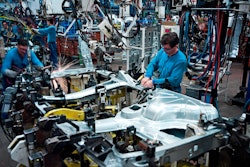
With the challenges facing the trucking’s supply chain so well known, the opening supplier panel at Monday’s Heavy Duty Aftermarket Dialogue in Grapevine, Texas, didn’t spend much time dwelling on the obstacles their businesses are facing each day. In giving attendees “A Real-World View of the Aftermarket,” executives from Allison Transmission, Bendix and Haldex say most of their work these days focuses on the future — adapting to the current reality to fulfill as many orders as possible from OEMs, aftermarket distributors and service providers.
“This is the hardest problem I’ve ever tried to solve professionally because there’s no good answer,” says Mike Hawthorne, Bendix Commercial Vehicle Systems president and CEO. “We can’t make everyone happy.”
Hawthorne says Bendix’s order fulfillment strategy has prioritized unit down orders, with production lines and aftermarket stock orders following. “The wrestling match between OE and aftermarket has leaned toward OE to keep production lines going,” he adds.
Monday’s other panelists have used similar strategies. Allison Transmission’s John Coll, senior vice president, global marketing, sales and services, says unit down orders remain his company’s top priority but its fulfillment rates for OEM lines and aftermarket customers have been fairly close in recent months. At Haldex, where aftermarket represents a majority of its North American sales, Americas President Walt Frankiewicz says Haldex is fulfilling unit down orders as quickly as possible and meeting its OEM obligations where it has a standard position. It also has been able to support the aftermarket with other components where its OEM position isn’t required.
The trio say none of their solutions are ideal, but in such unique circumstances, they are proving to be the best short-term bandages to a substantial market rupture. Additionally, suppliers state they are doing everything they can to communicate every decision they make (and why they make it) to their customer bases so everyone understands how they are attempting to manage the current crisis. With no easy way out of their current predicaments, Frankiewicz says transparency is proving to be the best option for suppliers to alleviate customer concerns and maintain strong business relationships.
[RELATED: Key indicators remain intact for truck production]
“The one thing that separates us from the automotive industry — which is a bloodbath now — is the mutual trust and integrity between customers and suppliers,” he says. “Those relationships remain paramount moving forward.”
Hawthorne says transparency has been the biggest change in customer expectations over the last year. He says today’s customers demand explanations for price increases and insight into how suppliers are developing their new rates. Fortunately, he says most customers are accepting of those prices increases once informed of their origins.
Coll agrees. “What’s been really positive has been the maturity of everyone.”
Monday’s panel discussion, moderated by Chris Patterson, also touched on how the supply chain may continue to evolve in the next year. Monday’s panelists said they believe their raw material levels (save for semiconductors) are likely to normalize before their logistics challenges are solved. On logistics, Frankiewicz says Haldex has stopped shipping through the Port of Long Beach and Hawthorne jokes, “we cannot go out and just clear the Port of Los Angeles.”
Regarding semiconductors, Frankiewicz says the aftermarket is at a fulfillment disadvantage because the chips it requires are basic transistors and many existing production lines are prioritizing more advanced microprocessor chips that sell for substantially more.
“No one wants to make the transistor because they can make a microprocessor for 100 times more,” he says.
The suppliers also note new onshore semiconductor facilities are likely to be used to develop 5G technology that is more advanced than the trucking industry needs.
“Most of what we use are legacy chips; most of the recent investment is for new technology chips,” adds Coll.
As for when the market will return to some semblance of normal? The panelists freely admit they don’t know that.
“I have been wrong on this every time I’ve been asked the question for the last 18 months,” Hawthorne says. “I don’t have a magic silver bullet to shoot and kill the monster.”
Coll says Allison doesn’t either, but the company is working hard to evaluate real market demand (OE and aftermarket) and use that in its market forecasting. He says the best thing suppliers can do now is acquire as much market information as possible and make educated decisions moving forward. He says if everyone acts accordingly, eventually, the trucking industry will put today’s challenges behind it.
“The resiliency of the [commercial vehicle] industry is helping us. We’ve been in tough situations before — though maybe not exactly like this — and everybody works together and we get through it.”











